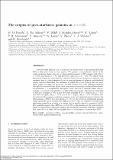Files in this item
The origins of post-starburst galaxies at z < 0.05
Item metadata
| dc.contributor.author | Pawlik, M. M. | |
| dc.contributor.author | Taj Aldeen, L. | |
| dc.contributor.author | Wild, V. | |
| dc.contributor.author | Mendez-Abreu, J. | |
| dc.contributor.author | Lahén, N. | |
| dc.contributor.author | Johansson, Peter H. | |
| dc.contributor.author | Jimenez, N. | |
| dc.contributor.author | Lucas, W. | |
| dc.contributor.author | Zheng, Y. | |
| dc.contributor.author | Walcher, C. Jakob | |
| dc.contributor.author | Rowlands, Kate | |
| dc.date.accessioned | 2018-03-16T10:30:14Z | |
| dc.date.available | 2018-03-16T10:30:14Z | |
| dc.date.issued | 2018-06-21 | |
| dc.identifier | 252564142 | |
| dc.identifier | c273edcf-b955-4cdc-a2d5-470d7d7aef96 | |
| dc.identifier | 85047144236 | |
| dc.identifier | 000434663200016 | |
| dc.identifier.citation | Pawlik , M M , Taj Aldeen , L , Wild , V , Mendez-Abreu , J , Lahén , N , Johansson , P H , Jimenez , N , Lucas , W , Zheng , Y , Walcher , C J & Rowlands , K 2018 , ' The origins of post-starburst galaxies at z < 0.05 ' , Monthly Notices of the Royal Astronomical Society , vol. 477 , no. 2 . https://doi.org/10.1093/mnras/sty589 | en |
| dc.identifier.issn | 0035-8711 | |
| dc.identifier.other | BibCode: 2018arXiv180302201P | |
| dc.identifier.other | ORCID: /0000-0002-5263-2427/work/42734895 | |
| dc.identifier.uri | https://hdl.handle.net/10023/12960 | |
| dc.description | MMP, VW, JM-A, NJ and KR acknowledge support of the European Research Council via the award of a starting grant (SEDMorph; P.I. V. Wild). LTA acknowledges support from the Iraqi Ministry of Higher Education and Scientific Research. NL acknowledges the support of the Jenny & Antti Wihuri Foundation. NL and PHJ acknowledge the support of the Academy of Finland project 274931. YZ ac- knowledges support of a China Scholarship Council Univer- sity of St Andrews Scholarship. WL acknowledges support from the ECOGAL project, grant agreement 291227, funded by the European Research Council under ERC-2011-ADG. | en |
| dc.description.abstract | Post-starburst galaxies can be identified via the presence of prominent Hydrogen Balmer absorption lines in their spectra. We present a comprehensive study of the origin of strong Balmer lines in a volume-limited sample of 189 galaxies with 0.01 < z < 0.05, log (M⋆/M⊙) > 9.5 and projected axis ratio b/a > 0.32. We explore their structural properties, environments, emission lines and star formation histories, and compare them to control samples of star-forming and quiescent galaxies, and simulated galaxy mergers. Excluding contaminants, in which the strong Balmer lines are most likely caused by dust-star geometry, we find evidence for three different pathways through the post-starburst phase, with most events occurring in intermediate-density environments: (1) a significant disruptive event, such as a gas-rich major merger, causing a starburst and growth of a spheroidal component, followed by quenching of the star formation (70% of post-starburst galaxies at 9.5 < log ({M}⋆/{M}⊙) < 10.5 and 60% at log ({M}⋆/{M}⊙) > 10.5); (2) at 9.5 < log ({M}⋆/{M}⊙) < 10.5, stochastic star formation in blue-sequence galaxies, causing a weak burst and subsequent return to the blue sequence (30%); (3) at log ({M}⋆/{M}⊙) > 10.5, cyclic evolution of quiescent galaxies which gradually move towards the high-mass end of the red sequence through weak starbursts, possibly as a result of a merger with a smaller gas-rich companion (40%). Our analysis suggests that active galactic nuclei (AGNs) are ‘on’ for 50% of the duration of the post-starburst phase, meaning that traditional samples of post-starburst galaxies with strict emission line cuts will be at least 50% incomplete due to the exclusion of narrow-line AGNs. | |
| dc.format.extent | 6158163 | |
| dc.language.iso | eng | |
| dc.relation.ispartof | Monthly Notices of the Royal Astronomical Society | en |
| dc.subject | Galaxies: evolution | en |
| dc.subject | Galaxies: stellar content | en |
| dc.subject | Galaxies: structure | en |
| dc.subject | Galaxies: starburst | en |
| dc.subject | Galaxies: interactions | en |
| dc.subject | QB Astronomy | en |
| dc.subject | QC Physics | en |
| dc.subject | DAS | en |
| dc.subject.lcc | QB | en |
| dc.subject.lcc | QC | en |
| dc.title | The origins of post-starburst galaxies at z < 0.05 | en |
| dc.type | Journal article | en |
| dc.contributor.sponsor | European Research Council | en |
| dc.contributor.sponsor | European Research Council | en |
| dc.contributor.institution | University of St Andrews. School of Physics and Astronomy | en |
| dc.identifier.doi | 10.1093/mnras/sty589 | |
| dc.description.status | Peer reviewed | en |
| dc.identifier.url | http://adsabs.harvard.edu/abs/2018arXiv180302201P | en |
| dc.identifier.grantnumber | ERC-2012-StG-20111012 | en |
| dc.identifier.grantnumber | en |
This item appears in the following Collection(s)
Items in the St Andrews Research Repository are protected by copyright, with all rights reserved, unless otherwise indicated.

